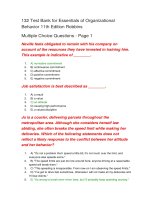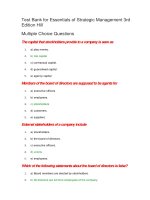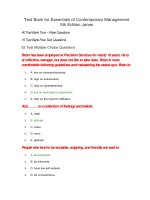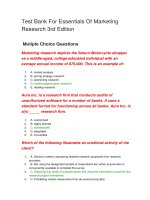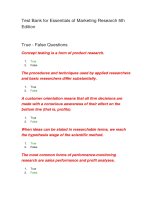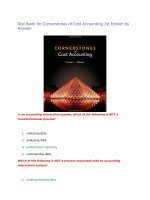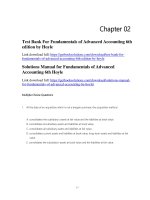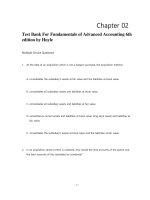Download test bank for essentials of contemporary business 1st edition by boone
Bạn đang xem bản rút gọn của tài liệu. Xem và tải ngay bản đầy đủ của tài liệu tại đây (192.98 KB, 4 trang )
CHAPTER 1
Test Bank for Essentials of Contemporary
Business 1st Edition by Boone
Vocabulary
1. a.
private property
11. branding
b. profit
12. technology
c.freedom of choice
13. outsourcing
d. fair competition
14. competition
2. a. natural resources
15. offshoring
b. human resources
16. critical thinking
c. capital
17. consumer orientation
d. entrepreneurship
18. entrepreneurs
e. 3. brand
19. factors of production
4. business
20. onshoring
5. capitalism
21. social responsbility
6. the age of industrial entrepreneurs 22. creativity
7. not-for-profit organizations
23. vision
8. relationship era
24. private enterprise system
9. transaction management
25. diversity
10. nearshoring
26. competitive differentiation
Analysis of Learning Objectives
LO 1.1:
1. F, 2. F, 3. T, 4. T.
LO 1.2:
1. b, 2. d, 3. a, 4. c.
LO 1.3:
1. T, 2. F, 3. T, 4.T, 5. F, 6. T. 7. F
LO 1.4:
1. T, 2. T, 3. T, 4. F, 5. F, 6. F, 7. b, 8. a, 9. d
LO 1.5:
1. F, 2. T, 3.F, 4. T, 5.F
LO 1.6:
Creativity is the capacity to develop novel solutions to
perceived organizational problems. Although most
people think of it in relation to writers, artists, musicians,
and inventors, that is a very limited definition. In
business, creativity refers to the ability to see better and
different ways of doing business. There are several
practice and mentalexercises that help to cultivate
creativity. For example, people can work on getting
themselves to think with a different mindset by
considering failures or encounters with new people as
learning experiences. People can keep a pen and notepad
with them at all times and record their dreams and
daydreams, which might produce effective ideas or
solutions to preexisting problems. Also, regular physical
exercise helps the body release endorphins, which spark
energy and creative thinking.
LO 1.7:
1. a, 2. d, 3. c, 4. d, 5. d
Self Review
True or False: 1. F, 2. T, 3. F, 4. T, 5. T, 6. T, 7. T, 8. F, 9. T,
10. T, 11.T,
12. F
Multiple Choice: 1. b, 2. c, 3. c, 4. c, 5. d, 6. d, 7. d, 8. a, 9. c, 10. d
Application Exercises
1.
Natural Resources: The book and snack shop owner might run on
power from a windmill, or some of the furniture could be
manufactured locally using local timber.
2.
Capital: The book and snack shop would use technology through
computers for the cash register and other purposes, such as
networking with customers or potential business partners through
social media sites.
3.
Human resources: The book and snack shop would have an owner
would helped train staff members and keep the books and
accounting records, a handful of employees serving as cashiers, and
possibly one baker/cook.
4.
Entrepreneurship: The owner of the book and snack shop would
have to be willing to take risks since he or she would be opening a
small business during economic hardships. The owner would also
need to be creative and follow a vision so that the book and snack
shop would have a competitive edge that would make customers
visit that particular shop over others that offered the same goods
and services.
Short Essay Questions
1.
Managers of the 21st century should be not only intelligent, but also
highly motivated and driven. They should also have a vision, which
entails knowing today’s market so that they know how they can design
a business that will succeed and have a competitive edge. Critical
thinking is also important for managers. The ability to think critically
means that managers can are capable of re-assessing situations when
they become problematic in order to be flexible. If there is a problem
with their business, a manager will be able to stay collected and
brainstorm solutions. Creativity is also important. Managers who are
creative will be able to create businesses that have a special niche in
today’s market that helps draw customers over competing businesses.
Similar to critical thinking, creativity also allows managers to
brainstorm solutions to problems, and think of failures as opportunities
for implementing new ideas.
2.
In the 1990s business moved from primarily transaction management
practices into the relationship era, in which businesses focuses on
building long-term relationships and loyalty with costumers. Having
long-term, loyal customers results in big paybacks, as it is easier to
keep customers than advertise to find new ones. New customers often
come from loyal customer referrals. These long-term relationships with
customers also allows the business to better learn its customers wants
and needs.

